2016 Hyundai Santa Fe light
[x] Cancel search: lightPage 77 of 699
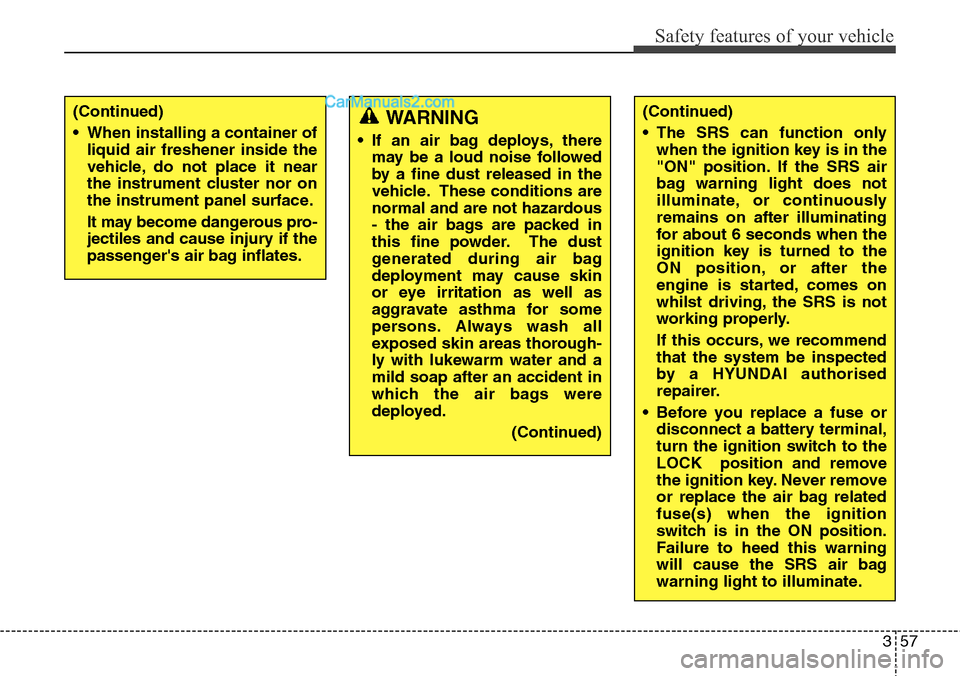
357
Safety features of your vehicle
WARNING
• If an air bag deploys, there
may be a loud noise followed
by a fine dust released in the
vehicle. These conditions are
normal and are not hazardous
- the air bags are packed in
this fine powder. The dust
generated during air bag
deployment may cause skin
or eye irritation as well as
aggravate asthma for some
persons. Always wash all
exposed skin areas thorough-
ly with lukewarm water and a
mild soap after an accident in
which the air bags were
deployed.
(Continued)
(Continued)
• When installing a container of
liquid air freshener inside the
vehicle, do not place it near
the instrument cluster nor on
the instrument panel surface.
It may become dangerous pro-
jectiles and cause injury if the
passenger's air bag inflates.(Continued)
• The SRS can function only
when the ignition key is in the
"ON" position. If the SRS air
bag warning light does not
illuminate, or continuously
remains on after illuminating
for about 6 seconds when the
ignition key is turned to the
ON position, or after the
engine is started, comes on
whilst driving, the SRS is not
working properly.
If this occurs, we recommend
that the system be inspected
by a HYUNDAI authorised
repairer.
• Before you replace a fuse or
disconnect a battery terminal,
turn the ignition switch to the
LOCK position and remove
the ignition key. Never remove
or replace the air bag related
fuse(s) when the ignition
switch is in the ON position.
Failure to heed this warning
will cause the SRS air bag
warning light to illuminate.
Page 80 of 699
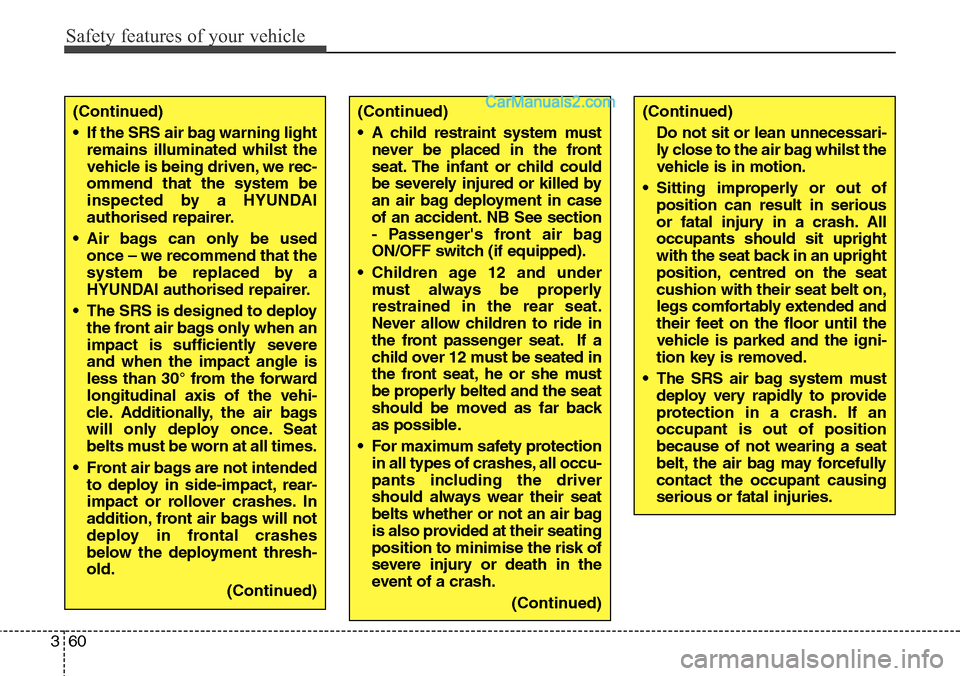
Safety features of your vehicle
60 3
(Continued)
• If the SRS air bag warning light
remains illuminated whilst the
vehicle is being driven, we rec-
ommend that the system be
inspected by a HYUNDAI
authorised repairer.
• Air bags can only be used
once – we recommend that the
system be replaced by a
HYUNDAI authorised repairer.
• The SRS is designed to deploy
the front air bags only when an
impact is sufficiently severe
and when the impact angle is
less than 30° from the forward
longitudinal axis of the vehi-
cle. Additionally, the air bags
will only deploy once. Seat
belts must be worn at all times.
• Front air bags are not intended
to deploy in side-impact, rear-
impact or rollover crashes. In
addition, front air bags will not
deploy in frontal crashes
below the deployment thresh-
old.
(Continued)(Continued)
• A child restraint system must
never be placed in the front
seat. The infant or child could
be severely injured or killed by
an air bag deployment in case
of an accident. NB See section
- Passenger's front air bag
ON/OFF switch (if equipped).
• Children age 12 and under
must always be properly
restrained in the rear seat.
Never allow children to ride in
the front passenger seat. If a
child over 12 must be seated in
the front seat, he or she must
be properly belted and the seat
should be moved as far back
as possible.
• For maximum safety protection
in all types of crashes, all occu-
pants including the driver
should always wear their seat
belts whether or not an air bag
is also provided at their seating
position to minimise the risk of
severe injury or death in the
event of a crash.
(Continued)(Continued)
Do not sit or lean unnecessari-
ly close to the air bag whilst the
vehicle is in motion.
• Sitting improperly or out of
position can result in serious
or fatal injury in a crash. All
occupants should sit upright
with the seat back in an upright
position, centred on the seat
cushion with their seat belt on,
legs comfortably extended and
their feet on the floor until the
vehicle is parked and the igni-
tion key is removed.
• The SRS air bag system must
deploy very rapidly to provide
protection in a crash. If an
occupant is out of position
because of not wearing a seat
belt, the air bag may forcefully
contact the occupant causing
serious or fatal injuries.
Page 82 of 699
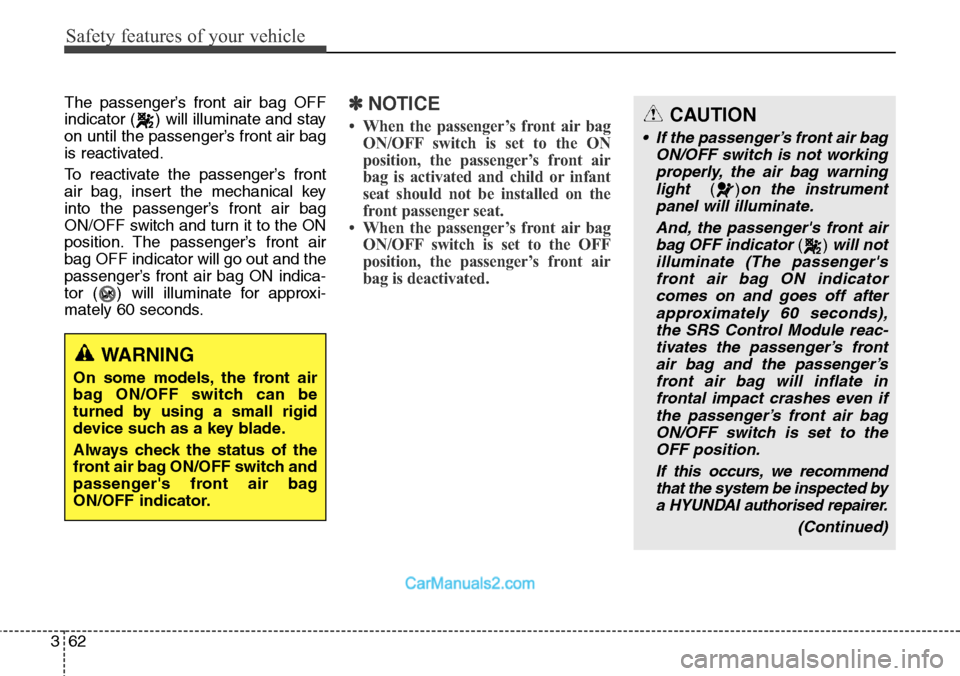
Safety features of your vehicle
62 3
The passenger’s front air bag OFF
indicator ( ) will illuminate and stay
on until the passenger’s front air bag
is reactivated.
To reactivate the passenger’s front
air bag, insert the mechanical key
into the passenger’s front air bag
ON/OFF switch and turn it to the ON
position. The passenger’s front air
bag OFF indicator will go out and the
passenger’s front air bag ON indica-
tor ( ) will illuminate for approxi-
mately 60 seconds.✽NOTICE
• When the passenger’s front air bag
ON/OFF switch is set to the ON
position, the passenger’s front air
bag is activated and child or infant
seat should not be installed on the
front passenger seat.
• When the passenger’s front air bag
ON/OFF switch is set to the OFF
position, the passenger’s front air
bag is deactivated.
WARNING
On some models, the front air
bag ON/OFF switch can be
turned by using a small rigid
device such as a key blade.
Always check the status of the
front air bag ON/OFF switch and
passenger's front air bag
ON/OFF indicator.
CAUTION
• If the passenger’s front air bag
ON/OFF switch is not working
properly, the air bag warning
light
()on the instrument
panel will illuminate.
And, the passenger's front air
bag OFF indicator
() will not
illuminate (The passenger's
front air bag ON indicator
comes on and goes off after
approximately 60 seconds),
the SRS Control Module reac-
tivates the passenger’s front
air bag and the passenger’s
front air bag will inflate in
frontal impact crashes even if
the passenger’s front air bag
ON/OFF switch is set to the
OFF position.
If this occurs, we recommend
that the system be inspected by
a HYUNDAI authorised repairer.
(Continued)
Page 83 of 699
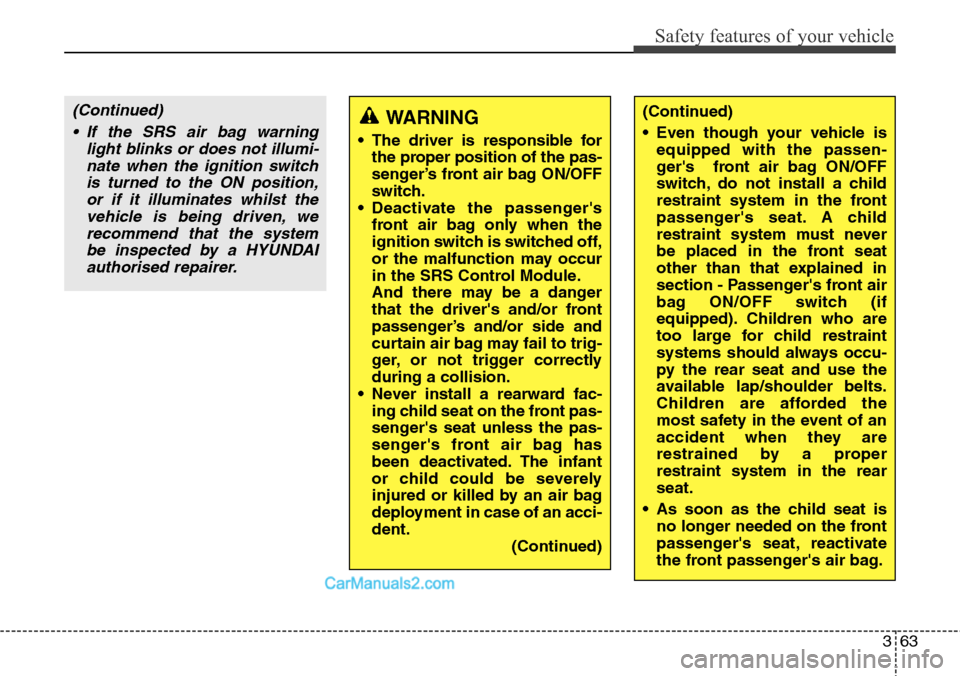
363
Safety features of your vehicle
(Continued)
• If the SRS air bag warning
light blinks or does not illumi-
nate when the ignition switch
is turned to the ON position,
or if it illuminates whilst the
vehicle is being driven, we
recommend that the system
be inspected by a HYUNDAI
authorised repairer.(Continued)
• Even though your vehicle is
equipped with the passen-
ger's front air bag ON/OFF
switch, do not install a child
restraint system in the front
passenger's seat. A child
restraint system must never
be placed in the front seat
other than that explained in
section - Passenger's front air
bag ON/OFF switch (if
equipped). Children who are
too large for child restraint
systems should always occu-
py the rear seat and use the
available lap/shoulder belts.
Children are afforded the
most safety in the event of an
accident when they are
restrained by a proper
restraint system in the rear
seat.
• As soon as the child seat is
no longer needed on the front
passenger's seat, reactivate
the front passenger's air bag.WARNING
• The driver is responsible for
the proper position of the pas-
senger’s front air bag ON/OFF
switch.
• Deactivate the passenger's
front air bag only when the
ignition switch is switched off,
or the malfunction may occur
in the SRS Control Module.
And there may be a danger
that the driver's and/or front
passenger’s and/or side and
curtain air bag may fail to trig-
ger, or not trigger correctly
during a collision.
• Never install a rearward fac-
ing child seat on the front pas-
senger's seat unless the pas-
senger's front air bag has
been deactivated. The infant
or child could be severely
injured or killed by an air bag
deployment in case of an acci-
dent.
(Continued)
Page 93 of 699

373
Safety features of your vehicle
SRS Care
The SRS is virtually maintenance-
free and so there are no parts you
can safely service by yourself. If the
SRS air bag warning light does not
illuminate, or continuously remains
on, we recommend that the system
be inspected by a HYUNDAI autho-
rised repairer.
WARNING
• Modification to SRS compo-
nents or wiring, including the
addition of any kind of badges
to the pad covers or modifica-
tions to the body structure,
can adversely affect SRS per-
formance and lead to possible
injury.
• For cleaning the air bag pad
covers, use only a soft, dry
cloth or one which has been
moistened with plain water.
Solvents or cleaners could
adversely affect the air bag
covers and proper deploy-
ment of the system.
(Continued)
(Continued)
• No objects should be placed
over or near the air bag mod-
ules on the steering wheel,
instrument panel, and the front
passenger's panel above the
glove box, because any such
object could cause harm if the
vehicle is in a crash severe
enough to cause the air bags to
inflate.
• If the air bags inflate, we rec-
ommend that the system be
replaced by a HYUNDAI autho-
rised repairer.
• Do not tamper with or discon-
nect SRS wiring, or other com-
ponents of the SRS system.
Doing so could result in injury,
due to accidental inflation of
the air bags or by rendering the
SRS inoperative.
(Continued)(Continued)
• If components of the air bag
system must be discarded, or if
the vehicle must be scrapped,
certain safety precautions must
be observed. A HYUNDAI
authorised repairer knows
these precautions and can give
you the necessary information.
Failure to follow these precau-
tions and procedures could
increase the risk of personal
injury.
• If your car was flooded and has
soaked carpeting or water on
flooring, you shouldn't try to
start the engine; we recom-
mend that you contact a
HYUNDAI authorised repairer.
Page 100 of 699
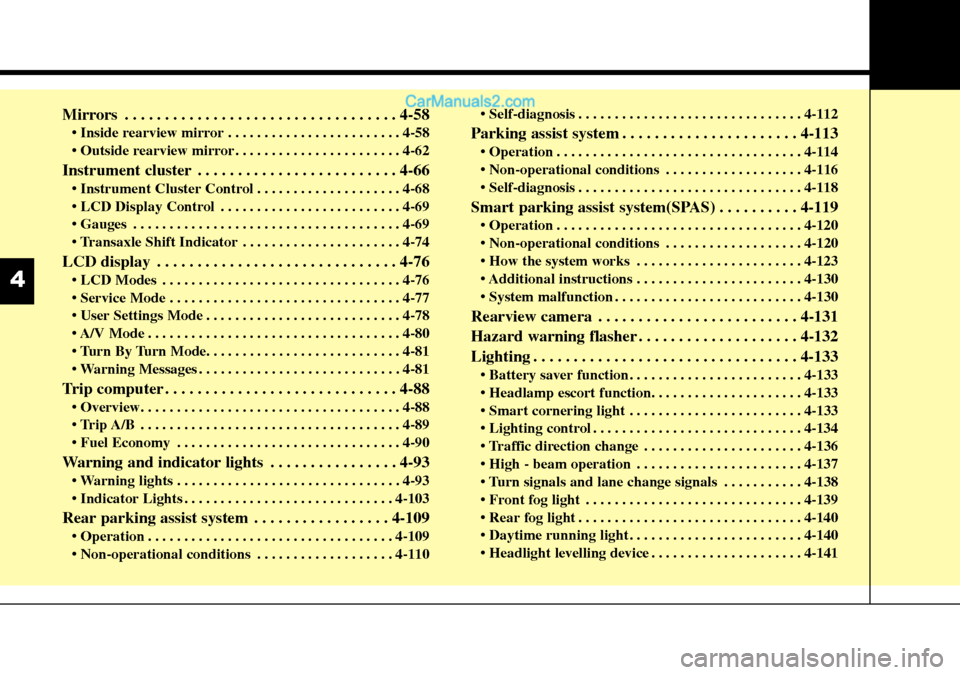
Mirrors . . . . . . . . . . . . . . . . . . . . . . . . . . . . . . . . . . 4-58
• Inside rearview mirror . . . . . . . . . . . . . . . . . . . . . . . . 4-58
• Outside rearview mirror . . . . . . . . . . . . . . . . . . . . . . . 4-62
Instrument cluster . . . . . . . . . . . . . . . . . . . . . . . . . 4-66
• Instrument Cluster Control . . . . . . . . . . . . . . . . . . . . 4-68
• LCD Display Control . . . . . . . . . . . . . . . . . . . . . . . . . 4-69
• Gauges . . . . . . . . . . . . . . . . . . . . . . . . . . . . . . . . . . . . . 4-69
• Transaxle Shift Indicator . . . . . . . . . . . . . . . . . . . . . . 4-74
LCD display . . . . . . . . . . . . . . . . . . . . . . . . . . . . . . 4-76
• LCD Modes . . . . . . . . . . . . . . . . . . . . . . . . . . . . . . . . . 4-76
• Service Mode . . . . . . . . . . . . . . . . . . . . . . . . . . . . . . . . 4-77
• User Settings Mode . . . . . . . . . . . . . . . . . . . . . . . . . . . 4-78
• A/V Mode . . . . . . . . . . . . . . . . . . . . . . . . . . . . . . . . . . . 4-80
• Turn By Turn Mode. . . . . . . . . . . . . . . . . . . . . . . . . . . 4-81
• Warning Messages . . . . . . . . . . . . . . . . . . . . . . . . . . . . 4-81
Trip computer . . . . . . . . . . . . . . . . . . . . . . . . . . . . . 4-88
• Overview. . . . . . . . . . . . . . . . . . . . . . . . . . . . . . . . . . . . 4-88
• Trip A/B . . . . . . . . . . . . . . . . . . . . . . . . . . . . . . . . . . . . 4-89
• Fuel Economy . . . . . . . . . . . . . . . . . . . . . . . . . . . . . . . 4-90
Warning and indicator lights . . . . . . . . . . . . . . . . 4-93
• Warning lights . . . . . . . . . . . . . . . . . . . . . . . . . . . . . . . 4-93
• Indicator Lights . . . . . . . . . . . . . . . . . . . . . . . . . . . . . 4-103
Rear parking assist system . . . . . . . . . . . . . . . . . 4-109
• Operation . . . . . . . . . . . . . . . . . . . . . . . . . . . . . . . . . . 4-109
• Non-operational conditions . . . . . . . . . . . . . . . . . . . 4-110• Self-diagnosis . . . . . . . . . . . . . . . . . . . . . . . . . . . . . . . 4-112
Parking assist system . . . . . . . . . . . . . . . . . . . . . . 4-113
• Operation . . . . . . . . . . . . . . . . . . . . . . . . . . . . . . . . . . 4-114
• Non-operational conditions . . . . . . . . . . . . . . . . . . . 4-116
• Self-diagnosis . . . . . . . . . . . . . . . . . . . . . . . . . . . . . . . 4-118
Smart parking assist system(SPAS) . . . . . . . . . . 4-119
• Operation . . . . . . . . . . . . . . . . . . . . . . . . . . . . . . . . . . 4-120
• Non-operational conditions . . . . . . . . . . . . . . . . . . . 4-120
• How the system works . . . . . . . . . . . . . . . . . . . . . . . 4-123
• Additional instructions . . . . . . . . . . . . . . . . . . . . . . . 4-130
• System malfunction . . . . . . . . . . . . . . . . . . . . . . . . . . 4-130
Rearview camera . . . . . . . . . . . . . . . . . . . . . . . . . 4-131
Hazard warning flasher . . . . . . . . . . . . . . . . . . . . 4-132
Lighting . . . . . . . . . . . . . . . . . . . . . . . . . . . . . . . . . 4-133
• Battery saver function. . . . . . . . . . . . . . . . . . . . . . . . 4-133
• Headlamp escort function. . . . . . . . . . . . . . . . . . . . . 4-133
• Smart cornering light . . . . . . . . . . . . . . . . . . . . . . . . 4-133
• Lighting control . . . . . . . . . . . . . . . . . . . . . . . . . . . . . 4-134
• Traffic direction change . . . . . . . . . . . . . . . . . . . . . . 4-136
• High - beam operation . . . . . . . . . . . . . . . . . . . . . . . 4-137
• Turn signals and lane change signals . . . . . . . . . . . 4-138
• Front fog light . . . . . . . . . . . . . . . . . . . . . . . . . . . . . . 4-139
• Rear fog light . . . . . . . . . . . . . . . . . . . . . . . . . . . . . . . 4-140
• Daytime running light . . . . . . . . . . . . . . . . . . . . . . . . 4-140
• Headlight levelling device . . . . . . . . . . . . . . . . . . . . . 4-141
4
Page 101 of 699
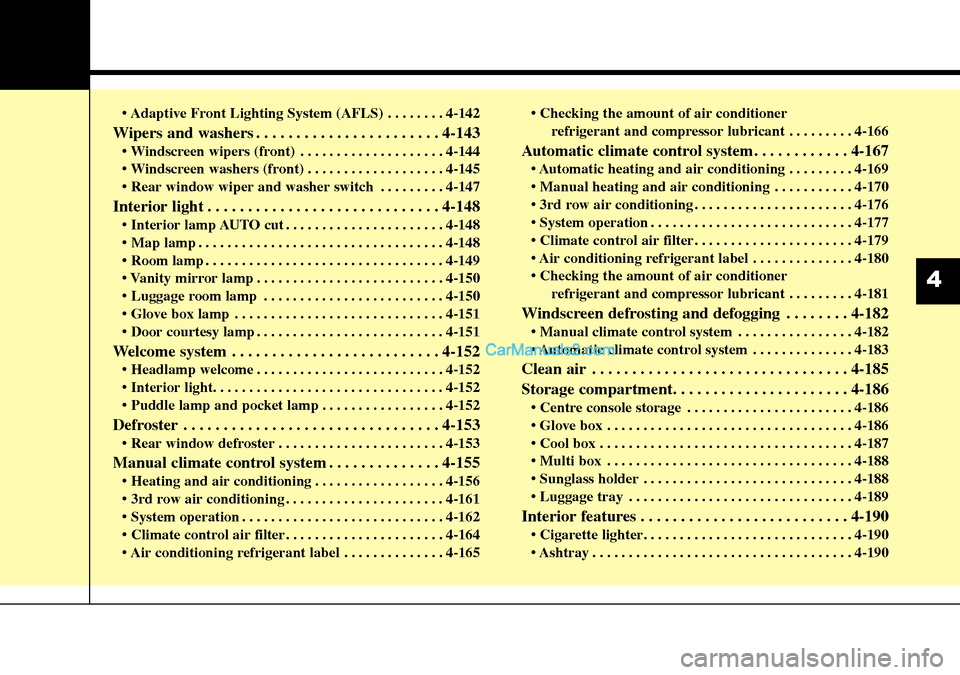
• Adaptive Front Lighting System (AFLS) . . . . . . . . 4-142
Wipers and washers . . . . . . . . . . . . . . . . . . . . . . . 4-143
• Windscreen wipers (front) . . . . . . . . . . . . . . . . . . . . 4-144
• Windscreen washers (front) . . . . . . . . . . . . . . . . . . . 4-145
• Rear window wiper and washer switch . . . . . . . . . 4-147
Interior light . . . . . . . . . . . . . . . . . . . . . . . . . . . . . 4-148
• Interior lamp AUTO cut . . . . . . . . . . . . . . . . . . . . . . 4-148
• Map lamp . . . . . . . . . . . . . . . . . . . . . . . . . . . . . . . . . . 4-148
• Room lamp . . . . . . . . . . . . . . . . . . . . . . . . . . . . . . . . . 4-149
• Vanity mirror lamp . . . . . . . . . . . . . . . . . . . . . . . . . . 4-150
• Luggage room lamp . . . . . . . . . . . . . . . . . . . . . . . . . 4-150
• Glove box lamp . . . . . . . . . . . . . . . . . . . . . . . . . . . . . 4-151
• Door courtesy lamp . . . . . . . . . . . . . . . . . . . . . . . . . . 4-151
Welcome system . . . . . . . . . . . . . . . . . . . . . . . . . . 4-152
• Headlamp welcome . . . . . . . . . . . . . . . . . . . . . . . . . . 4-152
• Interior light. . . . . . . . . . . . . . . . . . . . . . . . . . . . . . . . 4-152
• Puddle lamp and pocket lamp . . . . . . . . . . . . . . . . . 4-152
Defroster . . . . . . . . . . . . . . . . . . . . . . . . . . . . . . . . 4-153
• Rear window defroster . . . . . . . . . . . . . . . . . . . . . . . 4-153
Manual climate control system . . . . . . . . . . . . . . 4-155
• Heating and air conditioning . . . . . . . . . . . . . . . . . . 4-156
• 3rd row air conditioning . . . . . . . . . . . . . . . . . . . . . . 4-161
• System operation . . . . . . . . . . . . . . . . . . . . . . . . . . . . 4-162
• Climate control air filter . . . . . . . . . . . . . . . . . . . . . . 4-164
• Air conditioning refrigerant label . . . . . . . . . . . . . . 4-165• Checking the amount of air conditioner
refrigerant and compressor lubricant . . . . . . . . . 4-166
Automatic climate control system. . . . . . . . . . . . 4-167
• Automatic heating and air conditioning . . . . . . . . . 4-169
• Manual heating and air conditioning . . . . . . . . . . . 4-170
• 3rd row air conditioning . . . . . . . . . . . . . . . . . . . . . . 4-176
• System operation . . . . . . . . . . . . . . . . . . . . . . . . . . . . 4-177
• Climate control air filter . . . . . . . . . . . . . . . . . . . . . . 4-179
• Air conditioning refrigerant label . . . . . . . . . . . . . . 4-180
• Checking the amount of air conditioner
refrigerant and compressor lubricant . . . . . . . . . 4-181
Windscreen defrosting and defogging . . . . . . . . 4-182
• Manual climate control system . . . . . . . . . . . . . . . . 4-182
• Automatic climate control system . . . . . . . . . . . . . . 4-183
Clean air . . . . . . . . . . . . . . . . . . . . . . . . . . . . . . . . 4-185
Storage compartment. . . . . . . . . . . . . . . . . . . . . . 4-186
• Centre console storage . . . . . . . . . . . . . . . . . . . . . . . 4-186
• Glove box . . . . . . . . . . . . . . . . . . . . . . . . . . . . . . . . . . 4-186
• Cool box . . . . . . . . . . . . . . . . . . . . . . . . . . . . . . . . . . . 4-187
• Multi box . . . . . . . . . . . . . . . . . . . . . . . . . . . . . . . . . . 4-188
• Sunglass holder . . . . . . . . . . . . . . . . . . . . . . . . . . . . . 4-188
• Luggage tray . . . . . . . . . . . . . . . . . . . . . . . . . . . . . . . 4-189
Interior features . . . . . . . . . . . . . . . . . . . . . . . . . . 4-190
• Cigarette lighter. . . . . . . . . . . . . . . . . . . . . . . . . . . . . 4-190
• Ashtray . . . . . . . . . . . . . . . . . . . . . . . . . . . . . . . . . . . . 4-190
4
Page 107 of 699
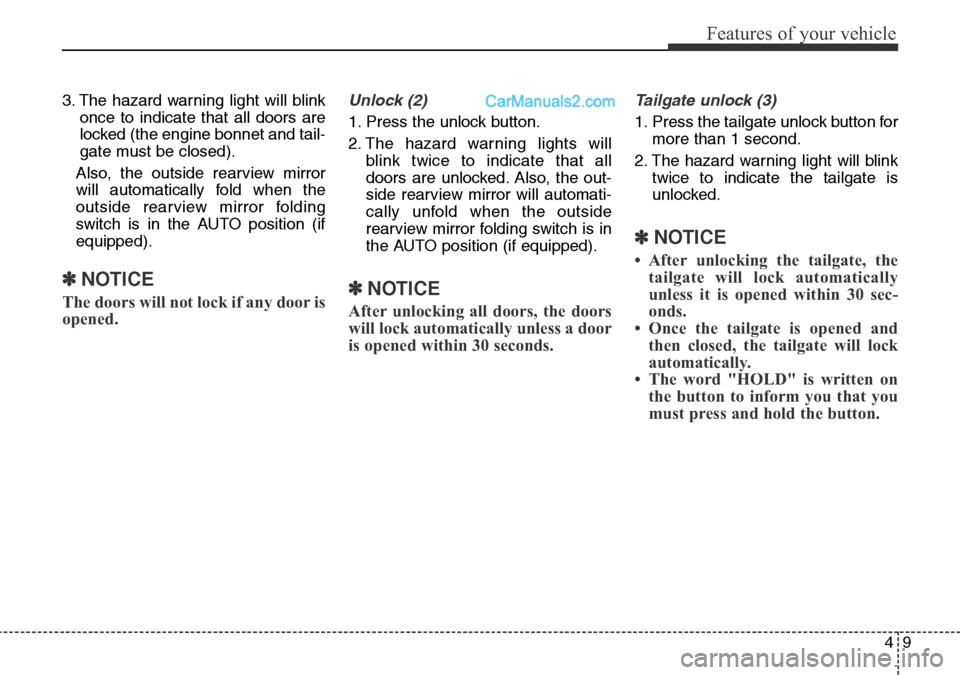
49
Features of your vehicle
3. The hazard warning light will blink
once to indicate that all doors are
locked (the engine bonnet and tail-
gate must be closed).
Also, the outside rearview mirror
will automatically fold when the
outside rearview mirror folding
switch is in the AUTO position (if
equipped).
✽NOTICE
The doors will not lock if any door is
opened.
Unlock (2)
1. Press the unlock button.
2. The hazard warning lights will
blink twice to indicate that all
doors are unlocked. Also, the out-
side rearview mirror will automati-
cally unfold when the outside
rearview mirror folding switch is in
the AUTO position (if equipped).
✽NOTICE
After unlocking all doors, the doors
will lock automatically unless a door
is opened within 30 seconds.
Tailgate unlock (3)
1. Press the tailgate unlock button for
more than 1 second.
2. The hazard warning light will blink
twice to indicate the tailgate is
unlocked.
✽NOTICE
• After unlocking the tailgate, the
tailgate will lock automatically
unless it is opened within 30 sec-
onds.
• Once the tailgate is opened and
then closed, the tailgate will lock
automatically.
• The word "HOLD" is written on
the button to inform you that you
must press and hold the button.